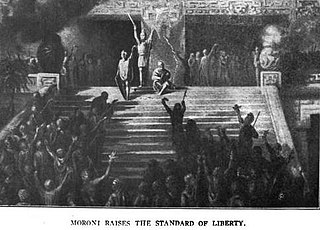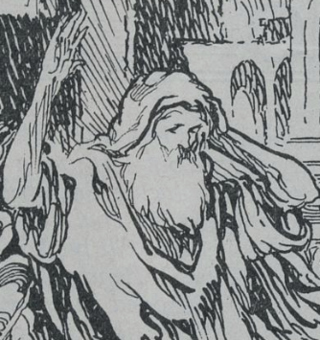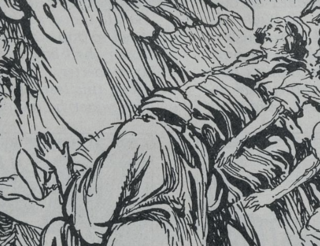
The Book of Alma: The Son of Alma, usually referred to as the Book of Alma, is one of the books that make up the Book of Mormon. The title refers to Alma the Younger, a prophet and "chief judge" of the Nephites. Alma is the longest book in the Book of Mormon and consists of sixty-three chapters, taking up almost a third of the volume.

The Book of Helaman is one of the books that make up the Book of Mormon, a text held sacred by churches within the Latter Day Saint movement, including the Church of Jesus Christ of Latter-day Saints. The book continues the history of the Nephites and the Lamanites from approximately 50 BC to 1 BC. It discusses political unrest among the Nephites and the formation of a group of secret dissenters called the Gadianton Robbers. Helaman, son of Helaman leads the Nephites for a time, and his sons Nephi and Lehi go on a successful mission to the Lamanites. When Nephi returns home, he correctly identifies the murderer of the chief judge using his prophetic powers, and sends a famine to the Nephite which lasts three years. After a digression from Mormon, the book of Helaman ends with Samuel the Lamanite's prophecy of the signs that will precede Christ's birth and death. Helaman deals with themes of external and internal conflict, hidden information, Nephite racism, and Mormon's views of history as deduced by his redaction of it.
The Book of Mosiah is one of the books which make up the Book of Mormon. The title refers to Mosiah II, a king of the Nephites at Zarahemla. The book covers the time period between ca 130 BC and 91 BC, except for when the book has a flashback into the Record of Zeniff, which starts at ca 200 BC, according to footnotes. Aside from stating that it was abridged by Mormon, the text says nothing about its authorship. Mosiah is twenty-nine chapters long.
The Second Book of Nephi, usually referred to as Second Nephi or 2 Nephi, is the second book of the Book of Mormon, the primary religious text of the Latter-day Saint Movement. Narrated by Nephi, son of Lehi, unlike the first Book of Nephi, 2 Nephi contains little history of the Nephite people and focuses predominately on visions and prophecies of Nephi himself and other prophets, particularly Isaiah.

The Book of Mormon mentions three men named Helaman. The first was the son of King Benjamin, king of the united Nephite-Zarahemla kingdom who lived in the 2nd century BC. Besides his genealogy, information about the first Helaman is limited. His brother, Mosiah, became heir to the throne.

Alma is a Nephite prophet in the Book of Mormon. Initially a priest who serves in the court of King Noah, when a prophet named Abinadi preaches to the court Alma concurs with Abinadi and affirms that what the prophet said is true. For this, Noah banishes Alma and tries to have him killed. After leaving the court, Alma goes on to found a church among Noah's subjects. He eventually leads these churchgoers out from Noah's lands, through a sojourn under Lamanite rule, and to the land of Zarahemla, where their ancestors had come from a few generations earlier, where Alma becomes high priest of the Nephites' church.

King Noah is a Nephite king in the Book of Mormon who appears in the Book of Mosiah. Noah rules over a Native American colony which came from Zarahemla and settled in the land of Lehi-Nephi, succeeding his father, Zeniff. In the Book of Mosiah, King Noah breaks away from his father's teachings, committing "all manner of wickedness." Noah and his priests sentence the prophet Abinadi, who prophesied of his kingdom's downfall if they did not repent, to death by fire. During a Lamanite invasion, Noah and some of his people flee the land, and those who remain are subjected to Lamanite control. Noah attempts to forbid his men from returning to their families, and they burn him at the stake. Noah is succeeded by his son, Limhi.

In the Book of Mormon, Alma, the son of Alma is a Nephite prophet often referred to as Alma the Younger to distinguish him from his father, who is often referred to as Alma the Elder. These appellations, "the Younger" and "the Elder," are not used in the Book of Mormon; they are distinctions made by scholars, useful because both individuals were prominent during the same time period in the Book of Mormon's story and filled a similar cultural and religious role. Alma is the namesake of the Book of Alma.

Ammonihah is a city mentioned in the Book of Mormon described as governed by lawyers and judges. When the Book of Mormon prophet Alma visits Ammonihah as part of a preaching tour, the city becomes the setting of "one of the most disturbing episodes" of the text in which Ammonihah's governing elite imprison him, exile any men converted by his preaching, and kill women and children associated with his mission by fire.
This chronology outlines the major events in the history of the Book of Mormon, according to the text. Dates given correspond to dates in the footnotes of the Church of Jesus Christ of Latter-day Saints edition of the Book of Mormon and to a Jaredite timeline proposed by Latter-Day Saint scholar John L. Sorenson.

In the Book of Mormon, the Zoramites were one of three major Nephite sects, existing during the administration of Alma the Younger as the High Priest over the Church of God. Zoram, the leader of this group, is first mentioned in Alma 30:59 as being the head of a people who "had separated themselves from the Nephites" and was responsible for the death of Korihor.

In the Book of Mormon, Zeezrom is a Nephite lawyer who, through deceit and money, seeks to gain power among the Nephites through his vocation. Alma the Younger and his missionary companion Amulek teach Zeezrom in Ammonihah. At first he resists, but is ultimately converted to the Nephite religion.

The Amalekites, in the Book of Mormon, are a group of Native American dissenters from the Nephites around 90 B.C. They are after the order of Nehor and therefore believe that there will not be a Messiah and repentance is unnecessary, so when Nephite missionaries come preach to them, only one Amalekite coverts. They also press the Lamanites to war against the Nephites multiple times and participate in the destruction of Ammonihah.

According to the Book of Mormon, the Amlicites were a break-off group of Nephites in the Book of Alma, around 87 B.C. Their leader, Amlici, is not chosen by the people as king, so he and the Amlicites leave the Nephites and join the Lamanites. The Nephites win both of their battles with the Amlicites and Alma kills Amlici in the second battle.

Amulek is a man referred to in the Book of Alma, a section of the Book of Mormon. After being visited by an angel, he gives food to the prophet Alma, listens to his preaching, and becomes his missionary companion. Alma and Amulek preach in Ammonihah and are challenged by lawyers, primarily Zeezrom, who accuses Amulek of lying and teaching against their laws. They are brought before the chief judge of the land. The men who believe their teachings are thrown out of the city and the women and children are burned in a fire, which Alma and Amulek are made to watch. Then, they are imprisoned until Alma's prayer gives them the strength to break free and the walls of the prison split in two.

Abish is a figure in the Book of Mormon who plays a pivotal role in a missionary narrative. She is one of only three named women unique to the Book of Mormon.

The following outline is provided as an overview of and topical guide to the Book of Mormon:







